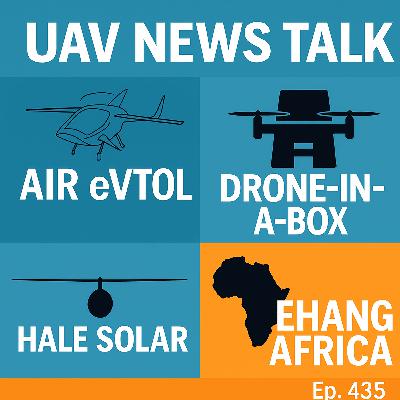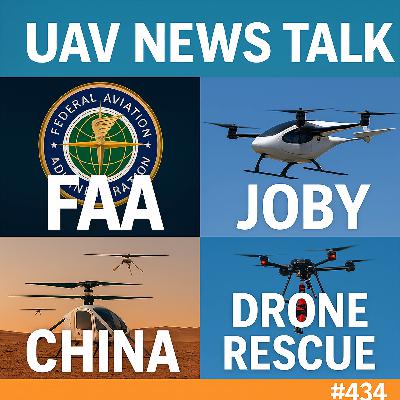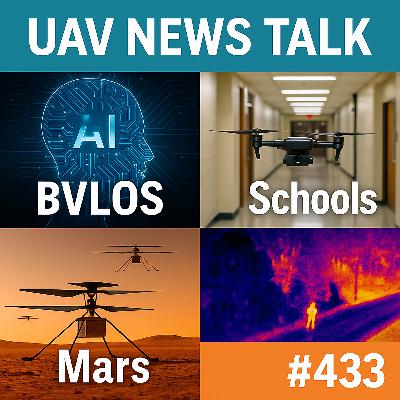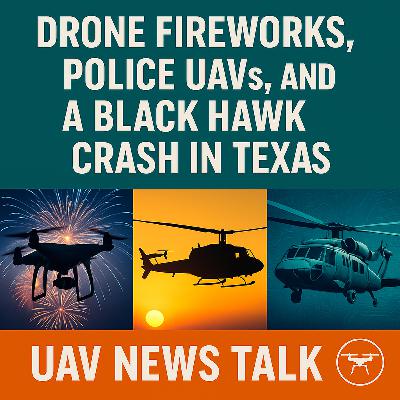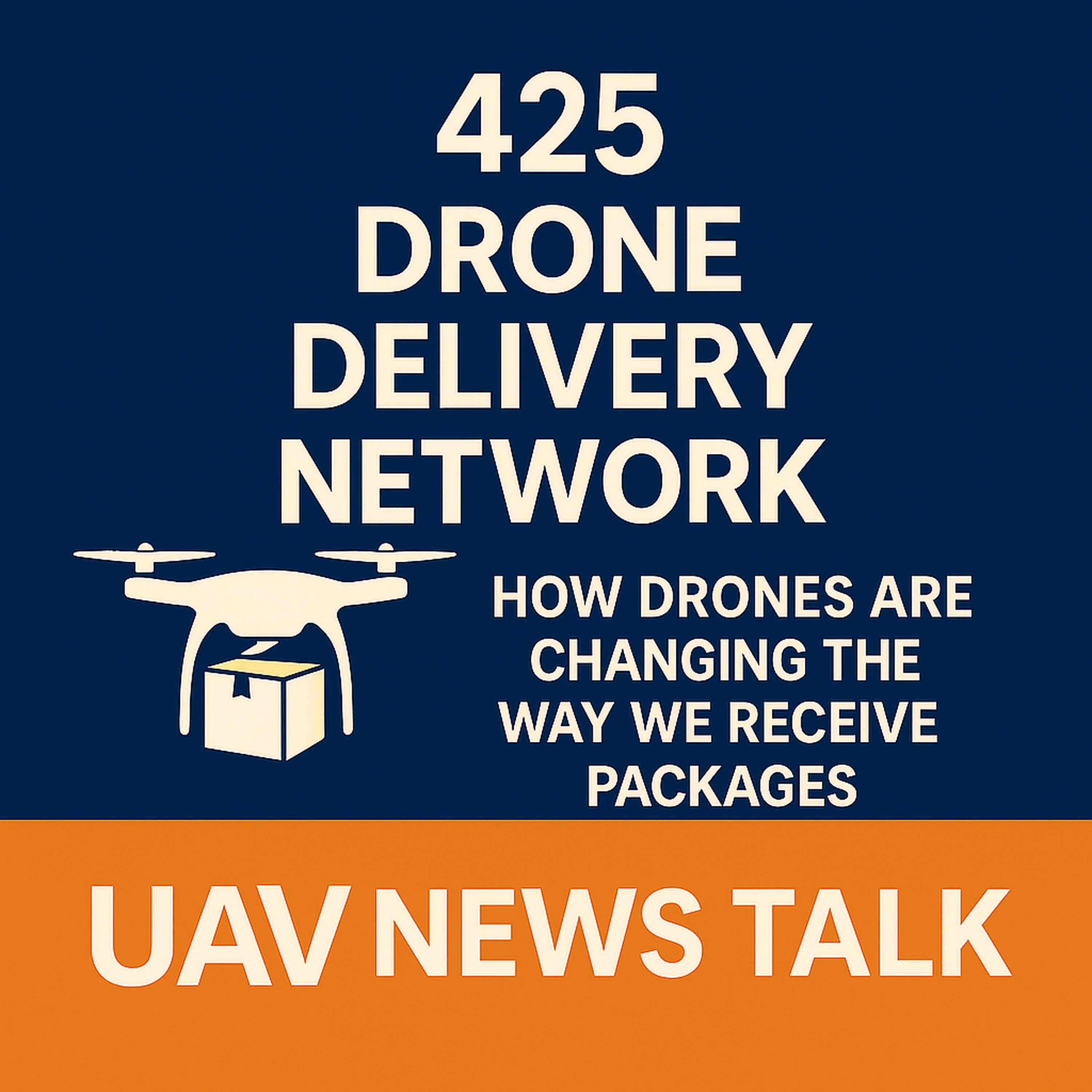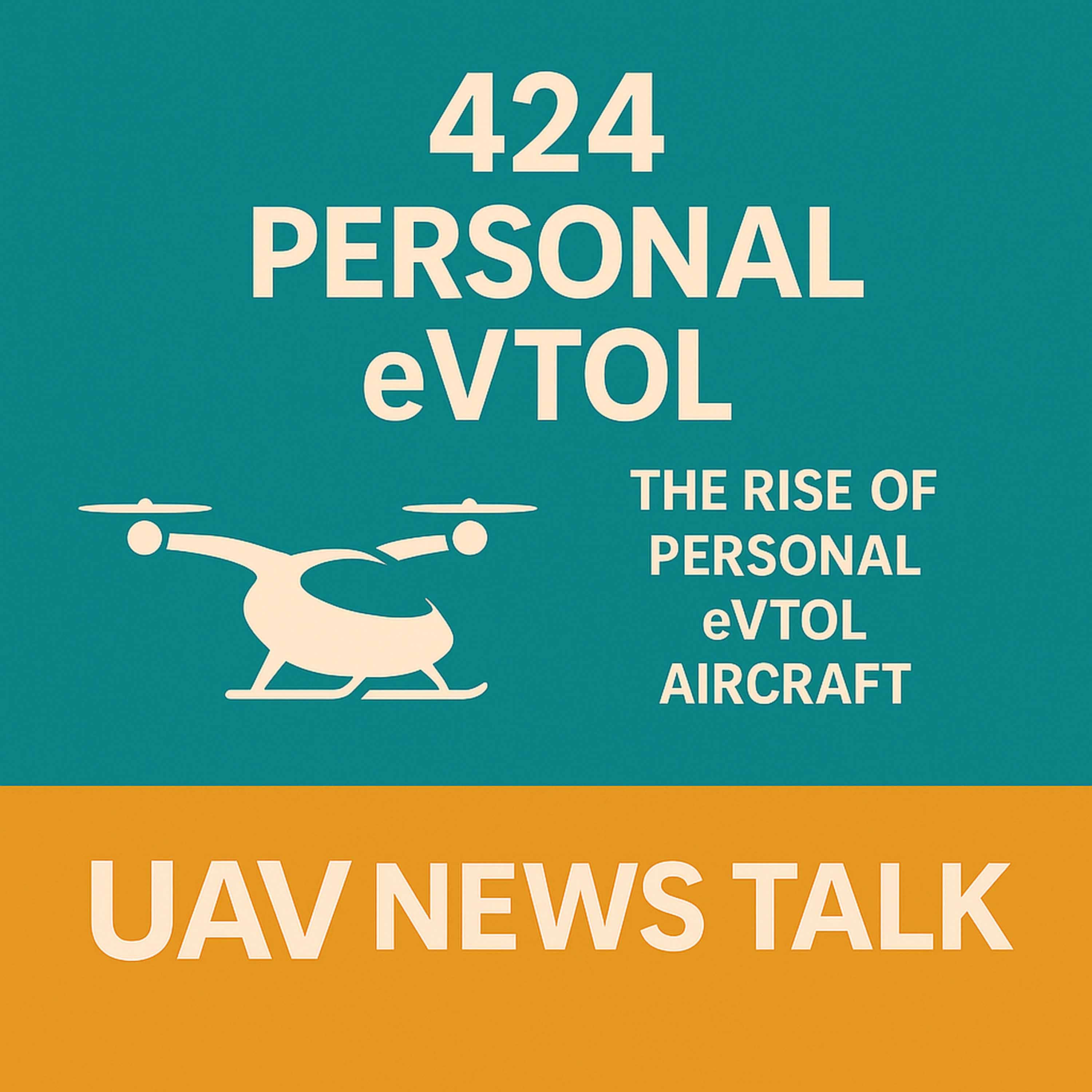Discover UAV News Talk – Drone News, eVTOLs, UAS Policy & Air Mobility
UAV News Talk – Drone News, eVTOLs, UAS Policy & Air Mobility

UAV News Talk – Drone News, eVTOLs, UAS Policy & Air Mobility
Author: Max Trescott | Aviation News Talk Network
Subscribed: 189Played: 5,618Subscribe
Share
© Glass Cockpit Publishing 2025
Description
UAV News Talk, formerly The UAV Digest, is your go-to source for drone, UAV, UAS, and eVTOL news. We cover the latest developments in drone regulations, pilot certification, emerging tech, advanced air mobility (AAM), and real-world use cases across industries. Whether you’re a drone pilot, developer, policy maker, or just an aviation enthusiast, you’ll find something in every episode to keep you informed and ahead of the curve. We talk about both commercial and military applications from all perspectives.
439 Episodes
Reverse
Max Trescott talks with David Hall, founder and CEO of Velodyne Space, about a new approach to counter-UAS defense that focuses on capturing drones using LiDAR, nets, and parachutes instead of destroying them.Hall begins by explaining LiDAR—Light Detection and Ranging—and how it measures distance by timing how long it takes for pulses of light to travel out and return. While LiDAR has existed for decades, Hall describes how his work during the DARPA Grand Challenge helped transform LiDAR from slow, single-beam mapping tools into spinning, multi-beam systems capable of real-time 3D perception. Those systems made it possible for autonomous vehicles to reliably understand their surroundings and plan motion in real time.Initially, Hall experimented with camera-based vision systems for self-driving vehicles, but he found they were easily confused by reflections, shadows, and visual artifacts. Writing software to compensate for every failure mode quickly became impractical. LiDAR offered a fundamentally different solution by providing direct distance measurements rather than inferred depth. By stacking dozens of laser beams vertically and rotating the entire sensor to achieve 360-degree coverage, Hall created a top-down, real-time view of the environment that proved autonomy was achievable.That experience—combining sensing, computation, and mechanical systems—eventually led Hall into the world of counter-UAS. Roughly a decade ago, he began exploring electromagnetic launch technology as an alternative to rockets for space launch. While studying high-power coil-based systems, Hall realized the same technology could be applied to a much more immediate problem: stopping drones.As drones have become more capable and more accessible, they’ve also become harder to defeat. Hall explains that many counter-UAS systems rely on electronic warfare techniques such as RF jamming, GNSS interference, or cyber takeover. These approaches can fail against autonomous drones or drones controlled via fiber-optic cables, which are increasingly common in conflict zones. Kinetic approaches, on the other hand, risk sending heavy debris falling into populated areas.Hall’s solution is a capture-based counter-UAS system. Instead of disabling a drone and letting it fall, the system fires a net that physically entangles the aircraft. Once captured, a parachute deploys, slowing the descent so the drone can fall safely even in populated environments. This makes the system particularly attractive for airports, cities, and other civilian infrastructure, where safety and liability are critical concerns.The system relies on a layered sensing approach. Cameras combined with AI identify drones and distinguish them from birds, while LiDAR provides precise range information needed to time the net deployment. Hall explains that LiDAR doesn’t need millimeter-level precision in this application; knowing distance within a few feet is sufficient to ensure the net opens at exactly the right moment. This combination allows the system to engage drones at distances approaching a thousand feet or more.A key advantage of the electromagnetic launcher is its rate of fire. Because the launcher can fire multiple low-cost nets per second, it can repeatedly engage a drone until one net successfully captures it. This capability also makes the system viable against drone swarms, which Hall believes represent one of the most serious emerging threats. Instead of relying on a single, high-value interceptor, the system overwhelms the problem with volume and repetition.Hall discusses the markets most likely to adopt capture-based counter-UAS systems, including airports—where a single drone sighting can shut down operations at enormous cost—prisons facing contraband delivery by drone, border security operations, and large public venues vulnerable to...
Max Trescott and David Vanderhoof tackle an unexpected reversal in global drone production and a growing crisis for the hobbyist drone community. The show opens with a headline few would have predicted a decade ago: Ukraine negotiating to produce drones for the U.S. military.David explains that after years of battlefield innovation, Ukrainian engineers have become world leaders in low-cost first-person-view (FPV) and kamikaze drone design. The proposal, reported by The War Zone, envisions a five-year, $50 billion program to produce up to 10 million drones annually. These aren’t large Predator-style aircraft but lightweight, single-use drones capable of swarming and overwhelming defenses. Max notes that instead of replacing airplanes, these weapons replace artillery shells, changing the economics and tactics of warfare. Both hosts see the deal as a remarkable symbol of Ukraine’s technical maturity—and a reminder that the U.S. may now be learning from a nation at war rather than supplying it.The second story turns domestic and controversial. Several California cities used drones to catch illegal fireworks, leading to fines exceeding $300,000 for one homeowner whose show produced 300 explosions. Each was recorded and counted by a city-operated drone at $1,000 per violation. David raises constitutional questions about warrantless aerial surveillance, while Max points out the state’s wildfire risk that motivates strict enforcement. They compare cities such as Brea and Anaheim, which issued much smaller or even zero citations, and wonder how long it will take before courts define what’s legal when drones are used for neighborhood enforcement.Next, Max introduces a topic from his home state of Pennsylvania. A local hunter used a drone to locate a wounded deer, prompting fines that were later dismissed. A state senator now proposes changing wildlife regulations to permit drone searches for downed game. David, also from Pennsylvania, notes that under current law, using “artificial means” such as a drone for tracking is prohibited. Max jokes that a drone large enough to lift a hundred-pound deer out of the woods would certainly attract attention—but admits it could save hunters’ backs and even lives.The duo then contrasts Pennsylvania’s reform effort with Kentucky’s new ban on using drones for any hunting or fishing activity. Kentucky allows UAVs only for research, enforcement, or removing invasive carp. David observes that ranchers in Texas and Oklahoma already use drones to herd cattle, highlighting how every state is creating its own patchwork of rules. Max predicts that, just as right-on-red traffic laws eventually became standardized, federal guidance will probably harmonize drone-wildlife laws within a decade.Humor keeps the conversation lively—Max quips that the FAA’s jurisdiction over fishing would only apply to “flying fish.” But their closing story is no joke. They discuss an article warning that the American drone-hobby industry faces an accessibility crisis. With DJI products banned from federal use and dwindling retail stock, newcomers are finding it harder to buy affordable, high-quality drones. The lack of alternatives, combined with strict FAA rules, could shrink the pipeline of young pilots and...
Episode 436 of UAV News Talk dives into global security, emerging automation, and the effects of Washington’s budget stalemate on the future of flight. Hosts Max Trescott and David Vanderhoof examine how nations, defense contractors, and innovators are redefining drone policy and autonomy at the same moment that the FAA’s own progress is slowed by the ongoing government shutdown.Germany authorizes police to counter rogue dronesThe show opens with the news that Germany has approved new counter-UAS authority allowing police to neutralize unmanned aircraft threatening airports and public safety. Max and David debate whether “shoot down” literally means gunfire or refers to electronic jamming and interceptor drones. Max notes that rogue drones have forced multiple Munich Airport closures—172 incidents in 2025 alone—leaving thousands of passengers stranded. David links the policy to Germany’s proximity to the Ukraine conflict, where drone incursions have heightened sensitivity across Europe. The hosts agree that while the measure feels drastic, persistent incursions make formal counter-drone rules inevitable.Drone-in-a-box systems chase shopliftersNext, the discussion turns to a futuristic retail-security concept: autonomous drones that pursue shoplifters once they leave a store. The hosts describe how “drone-in-a-box” platforms—similar to systems now deployed for school-campus emergencies—could track suspects until police arrive. Max imagines Apple Stores or high-end jewelers using such tools, while David questions cost and privacy implications. They joke about criminals splitting up so a single drone can follow only one thief. The takeaway: aerial surveillance is extending from military to consumer sectors, and regulation will soon need to catch up.Sikorsky’s fully autonomous U-Hawk - Video of the Week #1In one of the episode’s most popular segments, Sikorsky unveils the U-Hawk, an autonomous variant of the UH-60 Black Hawk helicopter. The cockpit has been removed entirely, replaced by cargo-bay clamshell doors for vehicles or supplies. David calls it “a major step beyond optionally piloted,” while Max compares it with Skyryse Aviation’s SkyOS, which retrofits existing aircraft for unmanned flight. Drawing from his own visit to Skyryse’s Southern California facility, Max explains how their flight-automation suite can be adapted to both helicopters and fixed-wing platforms. The hosts discuss potential missions—resupply, firefighting, and hazardous evacuations—and note that Boeing is exploring similar automation for the CH-47 Chinook. The ability to deploy heavy-lift helicopters without pilots, they say, could transform both logistics and combat operations.Mystery drones over New Jersey explainedA long-running puzzle also gets closure: the mysterious nighttime drone sightings over New Jersey that drew public complaints and congressional attention. New reports reveal that a private defense contractor conducted classified U.S. Army UAS demonstrations, accounting for many of the sightings. The hosts appreciate finally having an
Max talks with David Vanderhoof in Episode 435 of UAV News Talk about an especially busy week in drone, eVTOL, and military UAV news. The episode covers new FAA certifications, autonomous launch systems, solar-powered endurance flights, Chinese technology in Africa, U.S. counter-drone readiness, and even a domestic security case involving explosives and drones. Together, these stories paint a vivid picture of how fast the unmanned aviation sector is evolving — and where the biggest opportunities and threats lie.AIR eVTOL gains FAA Experimental CertificateThe first headline is the Israeli company AIR receiving an FAA experimental airworthiness certificate for its AIR One eVTOL. This isn’t the final approval needed for commercial operations, but it marks a critical milestone. The certificate allows AIR to expand its flight envelope testing in Florida — flying higher, faster, and with more maneuvering limits than before. Max explains that with this certificate, companies can begin validating systems under real-world conditions and build marketing buzz through legitimate flight footage.However, limitations remain: only essential crew can be onboard. No journalists, investors, or passengers are allowed until type certification and a production certificate are granted. David points out discrepancies in reported pre-orders — one source cites 150, another 2,500 — and the hosts remind listeners that early order numbers in this industry often need to be taken with caution.Max ties the discussion to the FAA’s MOSAIC rules for light-sport aircraft, which broaden certification pathways. These rules may make it easier for eVTOL manufacturers like AIR to secure final certification. For UAV enthusiasts and future pilots, this means the barriers to entry are slowly lowering, even if the process is still measured in years rather than months.Germany’s “Drone-in-a-Box”The second story introduces a “drone in a box” platform from Germany’s Skycar. This portable autonomous launch and recovery system can be mounted on trucks, ships, or rigid-hulled inflatable boats. Inside the box: a drone, charging system, and comms suite. Two models are supported, including the R70 SkyRanger, which can fly at up to 100 km/h.Max and David highlight how this technology, initially aimed at military markets, could quickly spill into commercial applications. Imagine delivery companies like UPS or Amazon mounting these on vehicles, enabling drones to launch, deliver, and recharge without human intervention. First responders could also benefit, deploying drones at wildfire scenes, active shooter incidents, or rescue operations. Even lifeguards or cruise ships might one day use such systems for rapid deployment of flotation devices or surveillance.The takeaway is that “drone in a box” technology represents a turnkey UAV ecosystem — plug it into any vehicle, and suddenly it’s drone-enabled.HALE Solar UAV Achieves 73-Hour FlightNext, the hosts discuss the U.S. Navy and SkyDweller Aero’s successful high-altitude long-endurance (HALE) UAV test at Patuxent River Naval Air Station. Powered by solar energy, the UAV stayed aloft for more than 73 continuous hours. Max compares this to Solar Impulse’s world-circumnavigation, noting that daytime solar climbs and nighttime battery descents make...
Max and David reunite for UAV News Talk episode 434, bringing listeners a wide-ranging discussion on the latest UAV, eVTOL, and rotorcraft developments.FAA Advisory Circular on Powered-LiftThey start with the FAA’s release of AC 21-17-4, the long-awaited certification guidance for powered-lift aircraft. Max explains how this 64-page document emphasizes performance-based outcomes rather than prescriptive design rules. Much of the content resides in Appendix A, covering equipment from cockpit voice recorders to flight data recorders. The standout requirement: aircraft must withstand impacts from a four-pound bird—a test historically performed with frozen chickens fired from “chicken guns.” David points out that eVTOLs, operating at lower altitudes, will likely encounter more bird strikes than traditional aircraft, making the requirement especially relevant.Joby Acquires Blade Passenger BusinessThe hosts then dive into Joby Aviation’s $125 million acquisition of Blade’s passenger business. Blade, known for helicopter and charter flights around Manhattan, gives Joby an existing customer base, operational infrastructure, and valuable experience. Max and David consider how quickly wealthy corporate travelers might switch from Sikorsky and Bell helicopters to Joby’s quieter eVTOLs. They expect a mixed fleet for years, with pricing likely used as an incentive to encourage adoption. The acquisition excludes Blade’s medical transport division but secures its premium commuter routes.China’s Two-Ton eVTOLChina’s aviation industry stunned observers with the unveiling of a two-ton eVTOL. Although the aircraft carries 880 pounds of payload—comparable to a Robinson R44—Max notes the figure is underwhelming relative to the aircraft’s size. David highlights its 124 mph cruising speed and one-hour endurance, branding it part of China’s new “low-altitude economy.” Max contrasts U.S. and European reserve requirements for electric aircraft, noting that European operators can fly with only a 10-minute reserve, boosting usable endurance. They also reference the FAA’s MOSAIC rules, which propose pilot certificates requiring just 20 hours of training for simplified eVTOL controls—though both hosts believe real-world training times will be closer to 40 hours.Ukraine’s Drone Bicycle RescueIn a dramatic wartime innovation, Ukraine used drones to deliver electric bicycles to a soldier trapped behind enemy lines. After multiple attempts, including one foiled by a landmine, the soldier finally escaped thanks to the unusual delivery. Max appreciates this rare “good news” drone story, contrasting it with the common use of UAVs as weapons. David likens the aerial surveillance role to Vietnam-era A-1 Skyraiders providing overwatch during rescues.Boeing Lawsuit and Startup DisputeThe discussion shifts to Boeing’s legal troubles with Zunum Aero, a Seattle-based hybrid-electric startup. After bankruptcy, Zunum sued Boeing for intellectual property theft. Though the case has bounced between rulings, the Ninth Circuit...
BVLOS rules, school safety drones, NASA’s Mars helicopters, and Michigan’s 40-mile drone research skyway take center stage in UAV News Talk episode 433, hosted by Max Trescott and David Vanderhoof. The discussion begins with the newly introduced LIFT Act—short for Leading Innovation in Flight Technology Act—proposed by Representative Jen Kiggans of Virginia on July 24, 2025. The bill would compel the Department of Transportation to accelerate FAA rulemaking for Beyond Visual Line of Sight (BVLOS) drone operations. The hosts explore how AI could be used to speed approvals, contrasting deterministic AI rule-checking with generative AI’s potential for errors, and weighing how this fits—or clashes—with the FAA’s traditionally deliberate safety-first approach.Next, the conversation shifts to Florida’s plan to trial armed drones for school security. Developed by Campus Guardian Angel, these drones would be stored on-site in protective boxes and launched within seconds to engage an active shooter—potentially firing powder pellets to incapacitate the suspect. Max and David raise practical questions about launch authority, piloting, targeting in chaotic conditions, and operational control from a central dispatch center. They note the program’s $1,000-per-month cost and early deployments in four Florida school districts and one Texas university.Video of the Week: A vivid example of drones aiding law enforcement—a Scottsboro, Alabama thermal video showing the nighttime capture of an attempted murder suspect hiding beside railroad tracks. The video’s bright, detailed imagery stands out from typical black-and-white thermal feeds, illustrating drones’ growing value in search and apprehension.From terrestrial policing to interplanetary exploration, the episode dives into NASA’s ambitious proposal to send six helicopters to Mars. Building on the Ingenuity mission’s unexpected 72-flight success, the new fleet could haul 11 pounds each, operate autonomously, and even act as communication relays to extend range. The hosts discuss rotor speed adjustments for Mars’ thin atmosphere, coaxial rotor benefits, and lessons from Ingenuity’s final hard landing caused by a rotor strike.Back on Earth, Michigan unveils its M Air Research Skyway—a 40-mile-long drone corridor enabling BVLOS operations, swarm testing, and drone traffic management (UTM) development. The University of Michigan’s engineering programs, private partners, and state agencies will collaborate to test delivery drones, advanced operations, and multi-drone coordination in a controlled yet realistic environment. Max notes the unique scale compared to most U.S. university programs, and David speculates on potential eVTOL or medical delivery applications.The episode wraps with a look at China’s booming “low-altitude economy” and its newly recognized profession: drone flight planner. With over 247,000 licensed drone operators and 2.17 million drones registered, China sees...
In Episode 432 of UAV News Talk, Max Trescott and David Vanderhoof explore the evolving role of drones in public events, law enforcement, and emergency response—highlighting both their growing utility and the risks of poor coordination. Titled "Drone Fireworks, Police UAVs, and a Black Hawk Crash in Texas," this episode covers breaking drone news from California and Texas, trends in UAV policing, and innovations in helicopter autonomy from Sikorsky and Skyryse.The episode opens with Max sharing a personal story about diving back into ham radio and noting the crossover with FPV drone pilots who use amateur radio frequencies for extended range. It’s a humorous but insightful segue into the broader theme: drones are becoming essential tools in unexpected places, from backyard hobbies to high-stakes public safety operations.🎆 Drones Replace Fireworks in San JoseThe first major story is about San Jose, California, where a last-minute shift from traditional fireworks to a July 4th drone light show occurred following a major fireworks factory fire in the Central Valley. With pyrotechnics canceled, city officials quickly pivoted to a drone display. The mayor noted that the cost of drone shows is “comparable to fireworks,” depending on the number of drones used. Max and David discuss how drone shows have grown increasingly sophisticated, but viewers should be aware that real-time transitions between drone formations are slower than what’s shown in sped-up YouTube clips.Drone light shows are not just a visual marvel—they’re also a safer and more sustainable alternative to traditional fireworks. This switch is becoming part of a national trend, particularly in fire-prone areas like California. But San Jose’s drone integration didn’t stop at entertainment.🚨 Police Drones Monitor Illegal FireworksSan Jose also deployed police UAVs to monitor for illegal fireworks across the city, joining another California municipality doing the same. Max shares how drone surveillance is increasingly used to spot unlawful activity on holidays like the Fourth of July. David warns hobbyists against the temptation to fly drones into fireworks displays for viral footage, noting that it’s both dangerous and illegal.These developments tie into a larger trend: law enforcement agencies across California are embracing drones as essential tools for first response. Max and David detail programs in San Jose, Alameda County, Elk Grove, and Los Angeles, where drones are now dispatched to emergency scenes—sometimes arriving before officers 74% of the time, as was the case in Elk Grove.Drones are being used to safely observe volatile situations like domestic disputes and fleeing suspects. In one example from San Leandro, UAVs tracked a suspect hiding under a box in a backyard, guiding officers to the location with minimal risk. Applications also include search and rescue, missing persons, and real-time crowd monitoring.👁️ Privacy Concerns and the Future of Police UAVsWhile the benefits are clear, David raises privacy concerns, such as whether UAV-collected evidence is admissible in court or if warrants are required. The discussion highlights
Max Trescott and David Vanderhoof dive into the future of drone delivery in Episode 431 of UAV News Talk. Max shares his firsthand experience receiving multiple packages via drone as part of a pilot program from Matternet, a Mountain View, California-based drone logistics company. After visiting Matternet’s headquarters and observing the behind-the-scenes operations, Max witnessed the packaging, pre-flight procedures, and live flight operations, including the dispatch and precise delivery of chocolate bars and snacks.Matternet’s program currently serves residents in Mountain View and Sunnyvale, delivering small items such as chocolates and drinks for free as part of a test initiative to gather feedback and flight data. Max details how customers apply to join the program, undergo a home site survey, and then place orders via a website. Deliveries are tracked in real time, and drones use tethers to gently lower packages into designated clear areas, where they automatically release the payload and return to base.Listeners hear live audio from Matternet staff explaining how deliveries are prepared, packaged, and executed under the watchful eye of a remote pilot monitoring telemetry and airspace conditions. Max describes the system’s precision and automation—including launchpads, a “mushroom-shaped” autonomous docking hub for future point-to-point missions, and how flight plans are uploaded for mostly autonomous execution.The drones, significantly larger than consumer quadcopters, are equipped with carbon fiber propellers and make a lower-pitched, deeper noise due to their larger rotors spinning at lower RPMs. The box itself, constructed of cardboard with padded interiors, is pristine upon arrival, having avoided the rough handling common in traditional delivery systems.David questions the economics of drone delivery, especially for low-cost items like chocolate, and Max suggests the long-term potential lies in delivering high-value or time-sensitive items, such as medical samples. They discuss how drone delivery is expanding, with Amazon, DoorDash, and companies like Flytrex, Zipline, and Alphabet’s Wing offering services in cities like Phoenix, College Station, and Dallas-Fort Worth.While drone delivery is advancing, both hosts acknowledge challenges remain—including weather, regulatory hurdles, noise concerns, and public perception. Max’s takeaway: while drone delivery isn’t yet widespread, real-world operations like Matternet’s signal that UAV logistics are finally reaching the cusp of mainstream adoption.Mentioned in the ShowMatternet390 Electric Airplane Test Flight: Max Trescott Reviews the Bristell B23 Energic
In episode 430 of UAV News Talk, Max Trescott and David Vanderhoof return from vacation with urgent news and safety concerns in the drone industry. The episode opens with a major headline: the DJI Mavic 4 Pro is not available in the United States. Although the drone boasts high-end specs—including a 6K camera and improved flight performance—it’s currently unavailable in the U.S. due to concerns about data security and alleged ties between DJI and the Chinese government.The ban stems from a long-standing effort by U.S. government agencies to restrict the use of DJI drones, especially after reports emerged that some DJI models were transmitting sensitive data back to China. The Pentagon, in particular, flagged DJI as a national security risk. In light of this, many online resellers and websites claiming to sell the Mavic 4 Pro may be scams. Max warns of fake DJI websites offering steep discounts, unauthorized sellers providing units without warranty coverage, and used drones that are “bricked” due to being locked to previous owners' DJI accounts. Buyers are urged to verify the source before purchasing any DJI drone—especially when new models are not officially available.Next, the discussion shifts to drone battery fires, a serious issue affecting both hobbyist and commercial UAV operators. Max highlights a recent vehicle fire in Mountain View, California, caused by a drone battery left charging on the passenger seat of a truck. Though the fire was extinguished quickly and injuries were minor, it serves as a critical reminder of the dangers associated with charging LiPo (lithium polymer) batteries in enclosed or flammable environments.In a separate and more devastating incident, a house in Kenosha County, Wisconsin was completely destroyed by a fire linked to drone batteries charging unattended. Tragically, several pets were lost in the blaze. According to reports, the batteries were connected to a newly purchased six-foot drone, and the homeowner had left them charging for hours while away from home. The episode underscores the importance of charging drone batteries only in safe, monitored locations—preferably on a non-flammable surface such as concrete and never inside unattended vehicles or homes.From fire hazards to electric flight innovation, Max and David then explore the historic cross-Atlantic flight of Beta Technologies’ Alia electric aircraft. The Beta Alia CX300, a fixed-wing eVTOL aircraft, is currently touring Europe and made headlines for flying across the Irish Sea under VFR rules. Its final destination is Bristow Helicopters in Norway, a company known for operating offshore flights to oil platforms.The Alia’s 250-nautical-mile range—significantly farther than most other electric VTOL aircraft—positions it as a promising alternative to traditional helicopters. Max notes that replacing helicopters for short regional missions is one of the most realistic and cost-effective early use cases for electric vertical takeoff and landing (eVTOL) aircraft. The Beta Alia also features fixed wings to improve lift and efficiency during cruise, giving it a hybrid profile that blends characteristics of both airplanes and helicopters.In defense-related drone news, the episode also covers the U.S. Department of Defense’s recent unveiling of two a...
Episode 429 marks a major milestone for the podcast formerly known as The UAV Digest, soon to be relaunched as UAV News Talk. Max Flight and David Vanderhoof return to the mic after a long hiatus to introduce new co-host Max Trescott, known for his work on the Aviation News Talk podcast and expertise in both fixed-wing and helicopter flying.The episode opens with a nostalgic look back to 2013, when Max Flight and David launched the show to cover the then-emerging drone landscape without overwhelming their other podcast, Airplane Geeks. They describe how the show evolved as they educated themselves and listeners about drone technology, regulations, and culture—sometimes even poking fun at questionable UAV behavior in their humorous “Grounded Files.”Max Trescott shares his excitement for the relaunch and the evolving UAV and eVTOL landscape near his home in California. He describes spotting test aircraft like Joby and Archer’s eVTOLs during recent flights and highlights how the focus is now shifting from promise to actual operations, citing companies like Matternet that are actively making deliveries.Please take our listener survey by going to theuavdigest.com/surveyWe greatly appreciate your feedback!UAV News Stories CoveredSciFly’s novel UAV design, which mimics helicopter performance using large, overlapping rotors, airfoil-shaped arms, and variable-pitch blades. The team praises its engineering and endurance (a two-hour hover test), while noting it depends on government contracts and future funding.Lyten’s lithium-sulfur battery technology, which promises lightweight, cobalt-free energy solutions better aligned with national defense needs. They discuss the geopolitical implications of battery sourcing and the importance of secure U.S.-based supply chains.Jetson ONE, a personal eVTOL dubbed the “flying motorcycle,” boasting joystick controls, 63 mph speeds, and 20 minutes of flight time. Max Trescott raises safety concerns, emphasizing the need for operational limits and robust pilot training—even for intuitive aircraft.Abu Dhabi’s hybrid heliport initiative, designed to accommodate both helicopters and eVTOLs. The group agrees that infrastructure development is essential for advanced air mobility, especially in cities like New York where vertiport space is scarce. They praise the UAE’s leadership and view it as a model for global adoption.Throughout the conversation, the hosts reflect on how UAV imagery has shifted over the years—from predator drones to quadcopters to today’s sleek eVTOLs. They also touch on persistent challenges, such as restricted flight zones, FAA registration, and airspace integration.The episode wraps with Max Flight officially passing the baton to Trescott and offering encouragement: stay curious, have fun, and involve the community. The team announces a listener survey at
If you’ve been a longtime listener, you know it’s been a while — actually, a couple of years — since our last episode. But the good news is: The UAV Digest is coming back!Since we last released an episode, the world of drones, UAVs, and advanced air mobility has evolved dramatically. And with so many exciting developments in technology, regulations, and industry trends, we want to make sure that the new version of the show stays in step with what matters most to you.When we return, the show will still have the spirit you remember, but there will also be some new and exciting changes. And that’s where we need your help.We’ve created a quick listener survey to hear your thoughts on what you’d like to hear in future episodes. It’ll only take a few minutes, and it will help shape the direction of the podcast as we move forward. You can find the survey at theuavdigest.com/survey.Now, you might be wondering why there haven’t been any new episodes for the past few years. David and I will be back in the next episode to explain the story behind the break, and what you can expect as we relaunch the show.In the meantime, please take a moment to visit theuavdigest.com/survey and share your thoughts. We’d really appreciate hearing from you.
Drone Safety Day is April 29, a drone that changes shape, jump-starting your car with a drone, Florida bans DJI from government agencies, decision-making for small UAVs, drones that work together without colliding, adding VTOL to a fixed-wing drone, agave farmers saving water, land a drone in Red Square.UAV NewsDrone Safety DayDrone Safety Day is Saturday, April 29, 2023. The annual campaign is dedicated to educating the drone community on the importance of flying safely. You can download the 2023 Drone Safety Day Playbook and 2023 Drone Safety Day Flyer. You can also visit the Drone@Home page to find ideas to participate at home. Register your event. Crazy shapeshifting drone inspired by dragons forces itself around objectsUniversity of Tokyo graduate students created drone prototypes that can rearrange into different structural shapes midair. The drones have individual segments with multi-axis gimbal systems. Each segment has its own propulsion unit, that can thrust in any direction. The drones can change their configuration to hold or move objects. They’ve also developed the SPIDAR quadruped robot that has joints in each leg and can fly.Could Drones Come Jump Start Your Car When You’re Stranded? Ford’s New PatentThis patent contemplates drones that assist motorists stranded with a dead battery. The Ford vehicle would transmit a “dead battery” signal and its location then a drone would fly to the vehicle, open the hood, connect to the battery, and jump-start the vehicle.Despite police outcry, DeSantis administration bans Chinese dronesFlorida Governor Ron DeSantis is forbidding government agencies from using drones manufactured by DJI. Only drones made by a small number of “approved manufacturers” can be purchased. Agencies have until January 1, 2023, to stop using drones not on the list. Many departments have already grounded their fleets. They told lawmakers that the Florida-approved drones are far more expensive and much less capable.Sen. Tom Wright, R-New Smyrna Beach said, I’m not going to let one officer risk his life or her life because somebody thinks that these things talk to China. I cannot imagine what China would really want to see when we pull over a DUI, when we stop a speeding car, when we arrest somebody for an outstanding warrant.”Making the skies safer with smarter dronesUniversity of Notre Dame computer scientists and engineers are developing an automated decision-making system for small drones under a $5.3 million 3-year NASA grant. Notre Dame will enhance NASA’s current drone traffic management system and develop...
uAvionix detects ADS-B spoofing, racing drones are delivering explosives, an aerial tanker that autonomously guides and controls multiple drones, self-flying F-16s that test loyal wingmen, the Condor heavy-lift UAV wins its first customer, a new mini light tactical UAS, and Archer Aviation and United Airlines plan air taxi service in Chicago.UAV NewsuAvionix Announces truSky ADS-B Spoofing Detection for SkyLine UAS BVLOS OperationsuAvionix offers its SkyLine UAS BVLOS service to manage the command and control infrastructure and assets across diverse frequency and radio types. Now the company is introducing truSky ADS-B spoofing detection for Skyline. It validates that a particular ADS-B signal is actually coming from an aircraft, and not being broadcast to spoof the signal.ADS-B spoofing can be used for nefarious purposes and interferes with ATC and detect and avoid systems. It compromises airspace awareness and risks airspace safety and security.uAvionix truSky works with a network of low-cost dual-frequency ADS-B ground receivers. The aircraft’s signal is confirmed to come from the aircraft’s position. With multiple sensors, truSky backward calculates the aircraft’s position and compares it to the position stated in the ADS-B transmission. When used with the uAvionix SkyLine platform, aircraft are color-coded based on confidence scores.How racing drones are used as improvised missiles in UkraineThe war in Ukraine seems to be demonstrating the use of drones in a conflict like never before. Ukraine is even using racing drones as loitering munitions. In a video released last year, a racing drone dives through an open doorway into a building occupied by Russian troops and explodes. There is even a Ukrainian military drone team called Angry Birds. They say they carry out half a dozen racing-drone attacks a day.Airbus tanker plane takes autonomous control of multiple dronesAirbus Defence and Space has autonomously guided and controlled drones using an A310 Multi-Role Tanker Transport (MRTT) flying testbed. The technology is called Auto’Mate, which cuts down on crew fatigue, human error, and training costs. This is seen as a milestone on the way to fully Autonomous Formation Flight and Autonomous Air-to-Air Refueling (A4R). US Air Force plans self-flying F-16s to test drone wingmen techThe Air Force plans a fleet of at least 1,000 collaborative combat aircraft, or CCA. But you can’t have loyal wingmen without trusted autonomy, so the service has asked for $50 million to start Project Venom (Viper Experimentation and Next-gen Operations Model). The project would let the Air Force experiment with six F-16s to test and refine the autonomous software.Drone Delivery Canada sells its first Condor heavy-lift UAVDrone Delivery Canada sold their first Condor heavy-lift UAV to the Transport Canada agency. The sale was valued at CAD $1.2 million...
Alphabet’s Wing subsidiary wants a drone delivery network, the Japanese Self-Defense Forces consider using drones to intercept aircraft, DJI is reportedly dropping AeroScope, U.S. Senators want an assessment of DJI security risks, cardboard drones from Australia are going to Ukraine, the USAF has plans for 1,000 loyal wingmen drones, Zipline’s next-generation aircraft, and Russian Su-27 fighter jets intercept a U.S. MQ-9 Reaper.UAV NewsGoogle company unveils drone delivery-network ambitionAlphabet’s Wing subsidiary is delivering up to 1,000 packages a day in Australia, but to scale up to millions of deliveries daily, Wing says it needs to develop a network service. The Wing Delivery Network would enable the management of large numbers of drones. This would consist of three hardware elements:The delivery drones.Pads where drones take off, land, and recharge their batteries.Autoloaders that allow companies to leave packages for collection.Delivery drones would travel from pad to pad (or node to node) rather than use fixed routes that return to a “home base” after each delivery.Video: The Wing Drone Delivery NetworkJapan weighs using drones to chase away foreign aircraftChinese military flights in the East China Sea have increased and scrambling jets is expensive for Japan. So the Japanese Self-Defense Forces (JDSF) are thinking about using drones instead, either the Turkish Bayraktar TB2 or the MQ-9 Reaper. It’s estimated that scrambling manned jets costs 40 times more than sending drones. The JSDF will first train its forces to use drones to identify foreign warships. If that proves successful, drones would be used to identify fast-approaching aircraft. Then if the threat is significant, the JSDF would send manned aircraft.DJI quietly discontinues its drone-detecting AeroScope systemAccording to The Verge, the DJI AeroScope product page displays a pop-up that reads: “The Aeroscope is no longer in production. For the latest in DJI technology, please view our product recommendations below.” AeroScope is a drone detection platform that identifies UAV communication links and gathers information in real time like flight status, paths, and other information.Senators Request Cyber Safety Analysis of Chinese-Owned DJI DronesA bipartisan group of U.S. Senators is asking the Cybersecurity and Infrastructure Security Agency to conduct an investigation and evaluate potential risks associated with DJI drones. In its letter, the Senators say, “Identification of this relationship between DJI and the PLA [People’s Liberation Army] suggests a range of risks to U.S. operators of the technology, including that sensitive information or data could wind up in PLA hands.”Paper Planes? Ukraine Gets Flat-Packed Cardboard Drones From Australia
Another personal eVTOL, cops flying BVLOS, military drones with facial recognition, a lethal drone designed in Australia, the Lilium Jet eVTOL, and moving air quietly.UAV NewsIs this one-seat flying saucer the future of flight?ZEVA Aero designs and builds electric Vertical Takeoff and Landing (eVTOL) vehicles. The company’s flagship product is the Argon, based on a pre-existing airframe. But their Zero is a personal eVTOL for one person. It launches with the pilot standing, but the position is prone in horizontal flight. The 8-foot-wide flying saucer-shaped aircraft uses 8 propellers and is expected to cost $250,000.A one-eighth-scale model has been flight-tested and tethered tests are underway with a full-sized prototype. Zeva says the prototype should be ready for remote-controlled flights within a month, and tests with a pilot could take place in three to six months.Video: ZEVA 1/8 Scale Model flyingWelcome to Chula Vista, where police drones respond to 911 callsThe Chula Vista, California police department operates 29 drones. The program runs 10 hours a day, seven days a week using four launch sites. Officers routinely request aerial reconnaissance. More than 1,500 U.S. police departments use drones, mostly for search and rescue, to document crime scenes, and to chase suspects. About 225 police departments have FAA waivers to fly BVLOS. Privacy and civil liberty groups are taking notice.US Military Signs Contract to Put Facial Recognition on DronesThe Air Force’s Drones Can Now Recognize Faces. Uh-Oh.The U.S. Air Force plans to deploy facial recognition technology on drones. RealNetworks LLC has the contract to supply its SAFR technology on small drones used for special operations missions. RealNetworks says SAFR Scan is “the first full-featured intelligent biometric access controlled edge solution.”Australian-designed lethal drone to be unveiled at Avalon AirshowBAE STRIXBAE Systems Australia unveiled the armed STRIX VTOL at Avalon 2023. It’s a hybrid, tandem wing, multi-domain and multi-role UAS that could be used for air-to-ground strike, persistent ISR, and as a loyal wingman for military helicopters. It can carry up to a 160kg payload over 800km with a variety of munitions. The collapsed footprint is only 2.6m x 4.5m (roughly 8.5 x 15 feet).Lilium sees premium service entry for Lilium Jet eVTOLVertical flight takes a lot of energy and most eVTOL designs
Ameriflight plans to purchase cargo drones from Natilus and Saberwing, a plan for autonomous wind turbine inspections and repair, the American Security Drone Act, an arrest made for flying a drone at Dublin airport, a new hydrogen-powered octocopter drone, and Green and Blue UAS.UAV NewsAmeriflight adds 35 heavy-duty cargo drones to wish listAmeriflight is a regional cargo airline (Part 135) that operates 156 turboprop twins for customers such as FedEx, UPS, and DHL. They recently signed a tentative agreement with Natilus for pilotless cargo planes. Now Ameriflight has signed a Letter of Intent to purchase 35 VTOL cargo drones from Sabrewing Aircraft Co.Ameriflight has 15 bases across the Western Hemisphere with 200 service destinations throughout the United States, Canada, and Mexico, as well as the Caribbean and South America. They typically experience over 1,500 weekly departures.The Natilus agreement to purchase is for the Kona aircraft, a 3.8-ton payload, short-haul feeder uncrewed aerial vehicle. Nautilus says the Kona planes will be operated by remote control and have the ability to be fully autonomous at some point in the future. Project Using Automated Drones for Offshore Wind O&M Aims for Reducing Downtime and CO2 EmissionsThe Flexible Offshore Drone for Wind (FOD4Wind) project envisions a system that can conduct autonomous wind turbine inspections and repair as well as package deliveries from service operation vessels to offshore turbines.mFOD4Wind illustration, courtesy University of Southern Denmark.Drones would take off from service operation vessels and carry gear and tools to the nacelles of Siemens offshore wind turbines. The Upteko partner says “If we can replace sailing with drone flights from larger ships, then many of the trips around the wind farm will be saved. There is great potential in that – both in terms of time and CO2 emissions.”The project, which runs until the end of 2024, is first working with payloads of 12 kilograms, with a long-term goal for the drones to be able to carry a cargo of up to 100 kilograms.The FOD4Wind project is being undertaken by Siemens Gamesa (produces wind turbines), ESVAGT (operates the service operation vessels), Upteko (developer of the automated UAS), and the University of Southern Denmark (SDU) with Energy Cluster Denmark managing FOD4Wind.Warner, Scott Introduce Legislation to Ban Purchase of Drones
A global drone market report, aircraft control with artificial intelligence, a slow start to Amazon drone deliveries, drones disrupt flight operations at Dublin Airport, a testing service for microgravity research.UAV NewsChinese drone maker DJI is dominating the market – despite being blacklisted by the U.S.A report by Drone Industry Insights says: the global drone market was $30.6 billion in 2022 and it is expected to grow to $55.8 billion by 2026. DJI holds 70% market share. Global Drone Market Report 2022-2030 says that drone services will remain the biggest segment, but hardware will grow the fastest. Energy is the Industry with the highest adoption of drones. Cargo, courier services, intralogistics, and warehousing have the highest CAGR. Mapping and surveying is the top drone application, followed by inspection as well as photography and filming.AI Just Flew an F-16 for 17 Hours. This Could Change Everything.The Lockheed Martin VISTA X-62A training aircraft flew for more than 17 hours with artificial intelligence software, marking the first time AI operated a tactical aircraft. The VISTA is based on the F-16. Software allows it to mimic the performance characteristics of other aircraft.Amazon’s delivery drones served fewer than 10 houses in their first monthAmazon’s drones have reportedly delivered to fewer houses than there are words in this headlineAmazon has been making deliveries by drone in Lockeford, California, and College Station, Texas. But not many. According to The Information, as few as seven houses had received Amazon packages by drone – two in California and five in Texas. The report says the FAA has safety concerns since Amazon’s drone weighs around 80 pounds (and carries a five-pound payload) and they fly over roads and people. FAA said Amazon must ask for permission on a case-by-case basis and Amazon employees had to act as spotters.However, Amazon successfully argued last November that the new MK27-2 drone is safer and more autonomous and didn’t need as many humans or safeguards. See: Amazon Prime Air revised limitations 2023 (Corrected Copy) [PDF], a 64-page letter from FAA to Amazon Prime Air informing...
A large autonomous blended-wing cargo drone and a smaller electric cargo drone, the Eaglet takes flight, taser drones at public schools, the GAO recommends the FAA create a comprehensive strategy, the Dronut for inspections, two MQ-9 Reapers for a Dollar, and a BVLOS autonomous inspection solution.UAV NewsDrones will ‘push the boundaries of what is possible’ in air cargoThe Natilus Kona cargo drone looks a lot like the NASA X-48B blended-wing prototype. It’s autonomous so no need for pressurization and the blended wing design is efficient with up to a 50% reduction in emissions. It has a claimed 4.3-ton cargo capacity with a 900 nautical mile range. Natilus says they have “designed and developed” the aircraft. The patent-pending ‘Diamond’ cargo bay allows for 60% more volume. It’s designed for cargo and can hold a large configuration of standard pallets and outsized cargo. A remote pilot watches over.World’s largest electric cargo plane unveiled, here’s how far it can fly on its ownPyka unveiled a large, zero-emission autonomous electric cargo plane. The second-generation Pelican Spray is an autonomous electric aircraft designed for complex agricultural operations on farms. The Pelican Cargo features an extended range, increased payload capacity, and maximized cargo volume. A payload of up to 400 lbs can be carried in 66 feet of cargo space for a range of up to 200 miles (with a 20 min reserve). Video: Pyka Pelican Cargo Unveil – Large Autonomous Electric Cargo UAS GA-ASI’s Eaglet Takes Its First FlightGeneral Atomics Aeronautical Systems (GA-ASI) conducted a flight demonstration of the Eaglet Air-Launched Effect (ALE) at the Dugway Proving Grounds in Utah. The Eaglet was launched from a U.S. Army MQ-1C Gray Eagle Extended Range (GE-ER) UAS. The Eaglet is a low-cost survivable UAV that can be launched from a Gray Eagle, rotary-wing aircraft, or ground vehicles.Taser drones in schools? The idea isn’t completely kaputThere was some talk about the ethics of putting tasers on small UAVs to subdue dangerous people and using “shock drones” to protect schools. Several years ago, law enforcement company Axon asked its ethics board for input on the idea. After a year-long study, the board said it was not a good idea. Then the mass shooting at the school in Uvalde, Texas happened. Axon may be rethinking the idea.FAA Should Improve Its Approach to Integrating Drones into the National Airspace SystemThe U.S. Government Accountability Office (GAO) says the FAA has developed planning documents to manage efforts to integrate drones into the national airspace, but it does not have a comprehensive strategy. According to the GAO, a comprehensive strategy includes seven elements and the FAA has only four of them. The FAA’s documents do not identify drone integration goals and objectives and they only partially include milestones and
Toroidal Propellers offer a solution for multirotor noise, layoffs at Prime Air, Valkyrie drones for the US Marines, regulating advanced air mobility in Utah, mapping a radioactive environment with a collision-tolerant drone, and a cargo drone that can carry 100 pounds for 600 miles.UAV NewsToroidal Propellers May Quietly Pave the Way to UAM Package Deliveries and MoreMIT might have a solution for the noise produced by multi-rotor propellers. The Structural and Thermal-Fluids Engineering Group at MIT Lincoln Laboratory is experimenting with toroidal propellers. [PDF] The toroidal propeller consists of two blades looping together so that the tip of one blade curves back into the other.Key Features:Decreases signals in the frequency range to which humans are most sensitiveReduces noise without requiring supplementary components that add weight and increase power drawLessens the likelihood that the spinning propeller will cut, catch, or clip objects or surfaces in the drone’s path Achieves thrust comparable to that of a multirotor drone propellerAllows reliable fabrication with additive manufacturing techniques that make it possible to customize the propeller for various multirotor models and typesAmazon’s drone delivery unit hit with layoffs just as 10-year-old project finally launchesIt’s been a decade since Amazon’s Jeff Bezos unveiled the company’s drone project on 60 Minutes. Prime Air now has drone delivery operations in two small markets, but corporate cost-cutting is rampant in the tech industry. Amazon plans to cut 18,000 jobs and Prime Air is not immune. The company won’t say how many layoffs affect the program. Sources said employees in the design, maintenance, systems engineering, flight testing, and flight operations units were part of the layoffs.Marine Corps buying Valkyrie drones to investigate ‘future autonomous platforms’The Marines have a $15 million contract with Kratos for two XQ-58A Valkyrie drones. These large aircraft weigh about 6,000 pounds and have a 27-foot-wingspan. Likely missions include strike, intelligence gathering, and electronic warfare. Possible other applications are a “mothership” for small drones and the deployment of munitions.What is ‘advanced air mobility,’ and why is the Utah Legislature looking to regulate it?The Utah Legislature has been working on drone regulations and in 2022 a study group was formed to look at updating regulatory laws. A bill is now working through the state legislature that is described as a framework for regulation. Topics being discussed include tracking software for near-ground air traffic, noise concerns, and State supremacy over local jurisdictions
An autonomous drone that collects environmental DNA, a robotic wing that measures flapping performance, a Wyoming bill to outlaw drone flights over prisons, flying drugs into the U.S. with drones, and an ex-drone manager sues Amazon.UAV NewsSpecial drone collects environmental DNA from treesIf you want to find out what creatures live in an area, you can observe them or you can collect the “environmental DNA” they leave. Examples of external DNA include dead skin or feathers, waste, and fluids. These can be found in the soil, in water, or on rocks and tree branches. Collecting environmental DNA can be difficult and expensive. It can be unsafe if you have to climb up into the forest canopy to get the DNA samplesNow a special drone is being developed that can autonomously collect samples on tree branches. Collaborating are ETH Zurich, the Swiss Federal Institute for Forest, Snow and Landscape Research WSL, and environmental DNA (eDNA) specialist Spygen. (A French biotechnology company created in 2011 and specializing in molecular ecology.) The drone lands on a branch and adhesive strips collect the samples. DNA is extracted in the lab.Video: Special drone collects environmental DNA from treesEfficiency of flapping drones to be increased with wing-folding researchA recent study led by Lund University in Sweden found that birds fly more efficiently by folding their wings during the upstroke. This might have implications for flapping drones and could increase their propulsive and aerodynamic efficiency. In order to study the different ways that wings could flap, the research team constructed a robotic wing that can flap the way birds do but can also flap in ways birds don’t. Wind tunnel measurements record the performance of the wing. Biology researcher Christoffer Johansson says “Flapping drones could be used for deliveries, but they would need to be efficient enough and able to lift the extra weight this entails. How the wings move is of great importance for performance, so this is where our research could come in handy,”Bill Outlawing Flying Drones Over Prisons Soars Through Wyoming SenateThe Wyoming Department of Corrections says just two incidents have occurred in Wyoming that involve drones and prisons. (Those were attempts to deliver tobacco.) But other prisons have seen drone incidents. The Wyoming Corrections Director fears that drones could be used to spy on prisons and identify guards, inmates, and specific facility details. After the Senate vote, the legislation goes to the state House.It Looked Like A Nice Family Home. Cops Suspect It Was A Secret Drone Airport For MDMA...





